How Worried Should We Be About Spencer Strider?
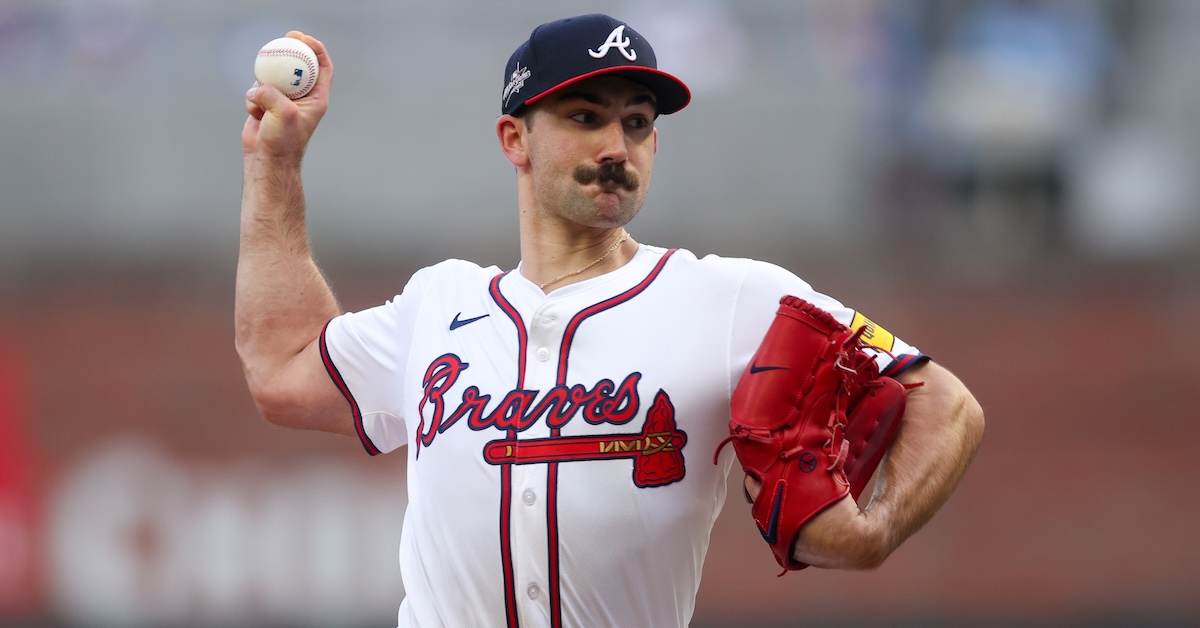
It’s not the results. I mean, it’s not not the results. Nobody feels good about an 0-4 record or a 5.68 ERA. But while the top line numbers are reason enough to worry about Spencer Strider, changes to his delivery and pitch shapes point to deeper concerns. The 26-year-old right-hander has made just four starts this season, but it’s reasonable to ask whether he’ll ever regain the form that just two years ago made him one of the most dominant forces in the game.
First and foremost, this stinks. Strider is a charismatic young player who’s easy to root for. When he’s at his best, standing bow-legged on the mound with his muscles threatening to shred his uniform pants, blowing 100-mph heat past anyone unlucky enough to find themselves in the batter’s box, he’s appointment viewing. After a cup of coffee in 2021, Strider burst onto the scene a fully-formed ace in 2022, laying waste to the league with a 98-mph fastball, a wicked slider, and a rumor of a changeup. From 2022 to 2023, his 2.43 FIP was the best among all starters, and his 10.3 WAR trailed only Kevin Gausman’s 10.7. Strider’s 3.36 ERA was 16th-best among starters with at least 300 innings pitched, and he looked for all the world like he would spend the rest of the decade as a true ace. Four games back from the internal brace surgery that wiped out nearly all of his 2024 season, we’re forced to reassess.
The reasons for optimism revolve around Strider’s injuries. Tommy John surgery cost him his sophomore season at Clemson in 2019, then COVID all but scuttled his junior season in 2020, but he still rocketed up the Braves system in 2021. So he’s returned from major surgery before; he just might not be all the way back from this one yet. He made two starts in spring training, but after his first regular season start in April, he ended up on the IL with a right hamstring strain, necessitating another rehab stint and ramp up.
Strider returned on May 19 and has made three starts since. It’s important to filter all of the bad news I’m about to dump on you through this lens. He might simply need a while to get back to his pre-surgery form. That’s entirely possible, and it’s certainly what anyone who loves baseball is hoping. “It just doesn’t come back overnight,” Braves manager Brian Snitker told reporters on Wednesday. “I wish it would. I know [Strider] does, but it’s a tough process.” Still, it’s hard to overstate how discouraging the early returns have been.
Strider has thrown just 19 innings, but he has looked like a completely different pitcher. At his best, he embodied the archetype of the strikeout ace who blew four-seamers by hitters up in the zone, but was also susceptible to the home run ball. Strider is still pitching like that guy, but he has yet to show the fastball that made the approach work. He’s still giving up the hard contact – in fact, his average exit velocity allowed is the highest of any player who’s thrown more than 12 innings – but his strikeout rate has fallen from nearly 37% in 2023 to just over 23% in 2025.
The bad news starts with velocity. Strider’s four-seam fastball is averaging 95.2 mph this season, down from 97.3 in 2023 and 98.2 in 2022. That’s still above average, but it takes Strider from the upper echelon down closer to the middle. His four starts this season represent the four lowest average fastball velocities of his career:
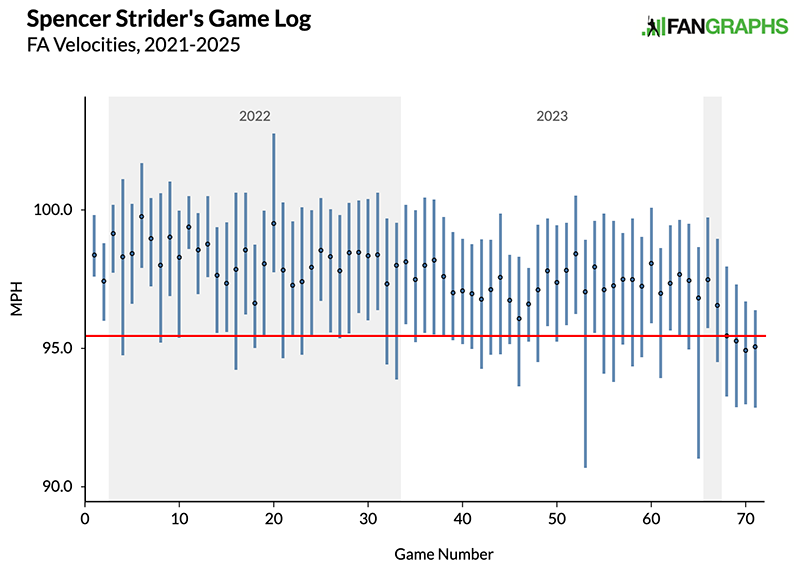
Strider’s slider has seen a similar drop, averaging 83.6 mph this season after averaging 85.6 in 2023. If you’re looking for a bright side here, the inning-by-inning breakdown might offer some comfort:
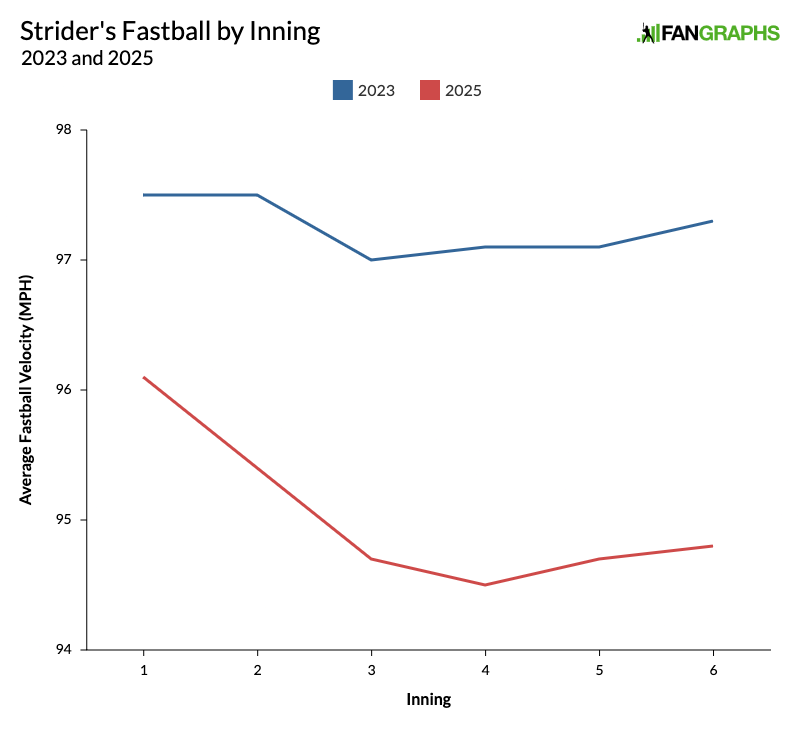
Even in the first inning, Strider is well below his 2023 average, but the major drop-off after that point gives us some hope that he’s still building up his strength and stamina. In 2023, his velocity dropped off after the first two innings, but that was a matter of half a mile per hour. So far this season, we’re talking about a drop-off roughly three times that size.
It’s not just that Strider’s fastball is slower, though. From 2023 to 2025, his arm angle has dropped from 48 to 41:
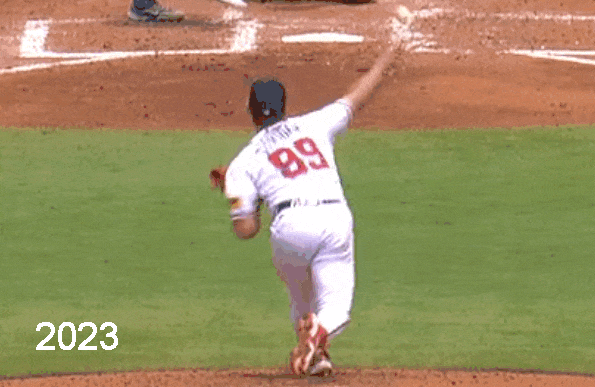
The pitch’s spin rate has also dropped slightly, even after accounting for the drop in velocity. In all, the pitch’s induced vertical break has fallen from 18.4 inches to 17.6, while its arm-side run has increased from 6.1 inches to 8.5. Let me hit you with some percentile ranks to show you what all this means. The table below shows where Strider’s four-seamer ranked among all pitchers who threw at least 100 of them in 2023 and 2025:
| Season | IVB | Velocity | Arm Angle |
|---|---|---|---|
| 2023 | 93 | 92 | 77 |
| 2025 | 71 | 66 | 56 |
Pitchers always trade vertical movement for horizontal movement when they drop their arm angles, but the vertical orientation of Strider’s four-seamer was one of the things that made it so special, and it no longer has that shape. It used to show batters something they rarely saw in terms of rise, velocity, and arm angle. This season, it looks like all the other fastballs that batters are used to seeing, and that makes it much more hittable. The pitch modeling tools are in agreement on that front:
| Season | PitchingBot | Stuff+ | StuffPro |
|---|---|---|---|
| 2023 | 67 | 118 | -1.3 |
| 2025 | 50 | 94 | 0.2 |
(Quick refresher: PitchingBot works on the 20-80 scouting scale, Stuff+ is based on a league average of 100, and StuffPro is based on a league average of zero, where negative numbers are good. This right here is part of why people hate analytics.)
At this point, PitchingBot is the only model that still sees Strider’s four-seamer as a league average offering. The results have been every bit as ugly as the models would expect. The pitch’s chase rate has fallen from 25.9% to 19.7% from 2023 to 2025. Its whiff rate has fallen by more than half, going from 28.7% to 14%. And batters aren’t just hitting it more often. They’re hitting it way harder. The pitch’s average exit velocity has increased from 90.1 mph to 95.3, and its barrel rate has jumped from 9.3% to 14.3%:
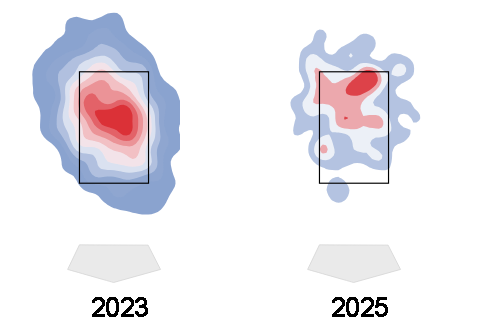
As you can see, Strider used to pump the fastball right down the middle because he knew he could blow it by people. This season, he can’t do that, so he’s been forced to be much more fine, trying to locate it at the very top of the zone.
I know we’re talking about small numbers. A couple ticks of velocity, a few degrees of arm angle, half an RPM per MPH, an inch or so of induced vertical break. But put them all together and we’re talking about a completely different pitch. The stuff models largely see it going from elite to below average, and so far the results have indicated the same.
Strider’s slider has undergone a similar change. Because he’s throwing it from a lower angle, it has added roughly half an inch of glove-side break, but it’s lost half an inch of drop (or, more accurately, it’s added half an inch of rise). Combined with the drop-off in velocity, it has also fallen to below average according to two of the stuff models, with StuffPro seeing it as right at league average. From 2023 to 2025, its chase rate has fallen from 43.9% to 30.3%. It’s still inducing whiffs just over half the time, but when batters connect, their hard-hit rate has increased from 33.3% to 55.6%, and their barrel rate has jumped from 7% to 11.1%. Possibly because he’s not inducing chases, Strider has also been leaving the pitch out over the plate much more often:

We have to assume that part of the reason the slider isn’t working is that it’s no longer playing off an unhittable fastball. I imagine that these changes have also made it slightly harder for Strider to tunnel the two pitches. The fastball breaks more to the arm side and the slider breaks more to the glove side, so their paths might diverge a bit sooner, making them easier to recognize. Strider’s changeup, as well as the curveball that he debuted in 2024, grade out about the same as they did before the injury, but the four-seamer and the slider are the big concern right now.
We keep coming back to the big questions. Are these changes temporary, are they permanent, or will Strider end up somewhere between? How much of his velocity will return as he continues to build himself up? There’s no way Strider and the Braves don’t know that his arm angle is lower. Will he ever be able to get back to the steep 48-degree angle he once achieved, or is it possible that dropping down some was an intentional decision? He’s already tinkering. As Lance Brozdowski noted on Wednesday, Strider has shifted way over on the rubber. He’s moved more than eight inches to his left, going from the middle to the extreme first base side.
The Braves have their own pitch modeling system, and they definitely know how Strider’s bread and butter are grading out right now. Their choice to keep him in the rotation indicates that they think he’s got more to offer. If they think that Strider can return to who he was before the injury — or at least the kind of pitcher he was before the injury, relying on the slider and four-seamer for chases and whiffs while doing his best to avoid hard contact — there’s not much to do other than let him figure it out and hope the results improve some in the meantime. Although the numbers are scary, we’re still talking about just four starts and 19 innings. A mediocre fastball/slider combo is a big step down, but it shouldn’t result in the worst exit velocity in the league either.
There’s no way for us to know how long it might take Strider to get back up to speed, but the longer he looks like this, the more reason there is to worry. If the previous version of Strider is gone forever, then he’s a different pitcher who needs to figure out a different approach. He’s already changed where he targets the fastball and the slider, but he won’t be able to throw them 90% of the time anymore. In a cruel twist, both Stuff+ and StuffPro see his curveball and his changeup as his best pitches right now.
A new version of Strider would have to do all the things that the earlier version was too magnificent to waste his time with. He’d have to change speeds and locations and incorporate more pitches. Cutter, sweeper, figure out a modified changeup grip, all the things mere mortals have to worry about. I have every confidence that Strider can figure that out if he needs to, but what a shame it would be for baseball to lose what he brought to it. It’s a brutal sport. After nearly 1,800 words, just about all the changes I’ve just described to you can be summed up like this:

That’s it. That’s the difference between a world-class pitcher and one who needs to learn to pitch all over again. It breaks your heart. It is designed to break your heart, not to mention your elbow.
Davy Andrews is a Brooklyn-based musician and a writer at FanGraphs. He can be found on Bluesky @davyandrewsdavy.bsky.social.
The analysis here is solid, and the overall takeaways stand. That said, I feel like the gif showing pitches between 2023 and 2025 is a bit misleading….focusing on the plate and batter’s boxes it’s pretty obvious that the camera angles are significantly different, making a visual comparison of Strider’s arm angle less reliable. The Statcast numbers are what they are, but the gif feels like using smoke and mirrors to bolster the point.
The point is his arm angle is lower, objectively. The gif isn’t proving anything, it’s just a fun and visually helpful illustration of the raw stat.
Hi RC, good eye, but the issue is actually Strider’s shift over to the first base side of the rubber. In order to put him in the center of both frames, I had to shift the whole screenshot over. I did make sure to grab two pitches when his arm angle was right at his season average. However, as Strider has only made four starts this season, I was unable to find two such pitches where he was in his original spot and the camera was zoomed in the same amount. Still, it’s much less about the angle than about the shift.